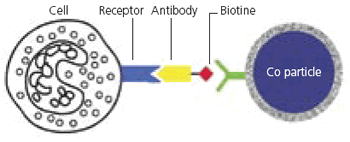|
Nanotechnology has the potential to increase our ability to understand the fundamental working of living cells. Many potential applications for metal nanomaterials as biosensors and biolabels are under investigation. They have found use in cellular studies, enhanced spectroscopic techniques, biochips, and protein and enzyme analysis.
Using Fluorescent Nanoparticles for Cell Labeling and Magnetic Nanoparticles as Sensors
Multi-color labeling of both fixed and living cells with fluorescent nanoparticles conjugated with biological ligands that specifically bind against certain cellular targets enables the recording of diffusion pathways in receptor cells. Uptake of nanoparticles into the vesicular compartments around the nucleus of cells can be used to label the cells so that their pathway and fate can be followed. The nanoparticles exhibit reduced photo-bleaching as compared to traditional dyes and are passed on to daughter cells during cell division, therefore allowing for much longer term observation. Magnetic nanoparticles can also act as sensors for assessing how external stresses affect changes in intracellular biochemistry and gene expression.
How Colloidal Gold Nanoparticles and Colloidal Gold Biofunctionalized Nanomodules Are Used to Monitor Cells
Colloidal gold nanoparticles have been found to strongly enhance the native signals of chemical constituents in cells. Surface Enhanced Raman Spectroscopy (SERS) relies on this signal magnification and serves as a tool for ultra-sensitive monitoring of the intracellular distribution of these chemicals. Colloidal gold biofunctionalized nanomodules also have potential for use in enzyme multi-sensors. Gold nanoparticles coated with proteins have been used to detect conformation changes in the attached proteins via observation of color changes in the solution.
Diagnostics
How Nanotechnology Methods Can Improve Medical Diagnostics
Early detection of disease remains a primary goal of the medical community. Nanotechnology holds great promise for enabling the achievement of this goal. Nanoparticles in particular have exhibited tremendous potential for detecting fragments of viruses, pre-cancerous cells, disease markers, and indicators of radiation damage. Gold coatings have made it possible to use toxic cobalt nanoparticles for biomedical applications.
Gold coated ferromagnetic nanoparticles tagged with HIV antibodies may be able to detect virus particles left after completion of conventional drug therapy. Metal nanoparticles in the form of dendrimers have also been functionalized with different biomolecules to detect specific proteins, antibodies, and other disease indicators. Fluorescent markers can also be attached to the dendrimers.
|

|
|
Figure 1. Diagram showing how nanoparticles can be used to detect diseased cells.
|
Early Cancer Detection Using Superparamagnetic Iron Oxide (USPIO) Particles and Magnetic Resonance Imaging (MRI)
Biomolecule coated ultra small superparamagnetic iron oxide (USPIO) particles injected in the blood stream recognize target molecular markers present inside cells and induce a specific signal for detection by magnetic resonance imaging (MRI). This technology may allow for detection of individual cancer cells months or years earlier than traditional diagnostic tools, which require the presence of hundreds of cancer cells.
How Biobarcode Amplification Assays (BCA) Use Nanoparticles in Disease Detection
A nanoparticle-based biobarcode amplification assay (BCA) utilizes gold nanoparticles and magnetic microparticles attached to large numbers of DNA strands and antibodies for a specific disease marker. The marker binds to the nano- and microparticles forming a complex that is separated from the sample using a magnetic field. Heating the complexes releases the DNA barcodes, which emit an amplified signal due to their large numbers. This BCA technology has been applied to the detection of markers for Alzheimer’s disease and is being investigated for numerous others.
Targeted Drug Delivery
How Nanotechnology Can Improve Targeted Drug Delivery Methods
Targeted drug delivery systems can convey drugs more effectively and/or more conveniently, increase patient compliance, extend the product life cycle, provide product differentiation, and reduce health care costs. Drug delivery systems that rely on nanomaterials also allow for targeted delivery of compounds characterized by low oral bioavailability due to poor water solubility, permeability and/or instability and provide for longer sustained and controlled release profiles. These technologies can increase the potency of traditional small molecule drugs in addition to potentially providing a mechanism for treating previously incurable diseases.
Using Magnetic Nanoparticles Targeted Drug Delivery - What This ‘Tag and Drag’ Process Involves
The use of magnetic nanoparticles in targeted drug delivery systems is under investigation by several research groups. Therapeutic drug molecules have been immobilized on the surface of magnetic nanoparticles or nanocrystals and directed to a specific target tissue using a magnetic field gradient. The drug is released by applying a radio frequency (RF) pulse. Gold coated iron, nickel and cobalt ferromagnetic nanoparticles have been employed in this “tag and drag” approach.
In hypothermal treatment, magnetic nanoparticles are directed to diseased tissue containing heat sensitive tumors. An AC magnetic field is applied such that the nanoparticles become heated, causing destruction of the cancerous cells.
More effective radiation therapy for tumor treatment can also be expected using metallic nanoparticles instead of, for example, magnetite. The nanoparticles allow the application of higher dosages of radiation at the tumor while sparing normal tissue.
Other Applications for Nanomaterials in the Medical and Pharmaceutical Sector
Numerous other potential applications exist in the medical and pharmaceutical field for nanomaterials from Strem. Areas currently under investigation include gene therapy, antibacterial/antimicrobial agents for burn and wound dressings, repair of damaged retinas, artificial tissues, prosthetics, enhancing signals for magnetic resonance imaging examinations, and as radio frequency controlled switching of complex biochemical processes.
List of Nanomaterials that Strem Can Supply to All Types of Industry
A listing of specific metal nanoclusters, metal nanocolloids (organosols and hydrosols), metal nanopowders, metal nanoparticles, and magnetic fluids offered by Strem is available upon request or via our website. Application sheets discussing the potential use of these products in the medical and pharmaceutical, defense and security, chemical, automotive, and energy fields, and as magnetic fluids, can also be obtained from Strem. More information is also available in the form of a reference sheet listing literature source materials.
|